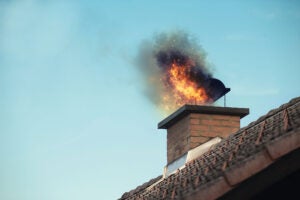Doug Shelburne described a chimney fire in blunt terms: “It sounds like a freight train running through your home.” Looking at one, he said, can conjure images of a massive Roman candle atop a roof.
“Make no mistake about it: Do no try to put it out yourself,” he said. “You call 911 and get out of that residence. Period.”
As the owner of Virginia-based Doug’s Chimney Sweep, Shelburne reinforces how dangerous the buildup of creosote can be on the interior of the flue. Chimney fires threaten not only the structural integrity of the chimney itself but also pose a risk to the whole of the home and those living there.
An annual cleaning is imperative, he said.
“Typically, a homeowner won’t know how close they are to having a chimney fire until it’s actually happening,” Shelburne said. “By that time, it’s too late. The chimney is on fire.”
These blazes originate from the residue of burned wood. When a log is burned, hot smoke travels up the chimney. As it rises, however, the vapors cool and form a liquid-like substance that can dry on the walls of the flue.
From there, all it takes is a particularly hot fire, a spark or an ember to ignite that highly flammable residue and create a chimney fire.
Chimney cleaning is “about saving houses and saving lives. You’re out here trying to prevent damage,” Shelburne said. “Nowadays, homes are so close to each other that if one goes, you can burn a whole neighborhood down. Realistically, if you have a house 20 feet away and you have a 2,000-degree chimney fire, it can easily catch the next residence on fire.”

There are several factors that contribute to the creation of creosote, but there’s only one that any good chimney sweep will point to every time: “Season your wood, plain and simple,” Shelburne said.
Seasoning involves reducing the moisture levels within wood. This is done by creating a covered environment that encourages airflow.
The minimum time to season hardwoods is eight months; oftentimes, a year will be more reassuring. Soft woods such as pine need even longer, as much as a year and a half, to get them seasoned appropriately thanks to the sap they have inside. A target moisture level is about 20 percent, Shelburne said.
A good seasoned piece of wood burns hot, constant and steady in a fireplace.
“If you cut your wood, split your wood, stack your wood and cover your wood for anywhere between eight and 12 months, there wouldn’t be these buildups of creosote,” he said.
Shelburne also said it’s important to let a fire burn out on its own — doing something such as pouring a glass of water on a blaze can cool it down too quickly and send heat shooting through the flue, potentially damaging the terracotta tile inside. Exhaust can then find its way into any cracks in the tile and fail to vent properly.
“The job of that flue tile is to exhaust whatever vapors are burning — be it wood, be it oil, be it gas — safely out of the house,” Shelburne said. “And if the tiles are cracked, they can’t do that effectively.”
A standard annual cleaning typically runs $180 to $200, and should be carried out by someone affiliated with the National Fire Protection Association, which certifies chimney sweeps.
Any home with a chimney, even ones that don’t burn wood, should be inspected annually. Shelburne said that a few times a year he encounters a home with a gas or oil furnace or a gas water heater that has a dead animal or other blockage in the exhaust, causing carbon monoxide to become trapped in the house.
“This is why you’re feeling bad, this is the headaches, the stomach aches, the body aches,” he said of those cases.
Shelburne admits that his craft, despite dating back centuries, is one that few people take part in anymore. But he sees immense value to what he brings to the livelihoods of those who use chimneys.
He said: “A couple of hundred dollars today can save you a couple of thousand dollars tomorrow.”
The story was originally published on smithmountainlake.com and is being reprinted with permission.



